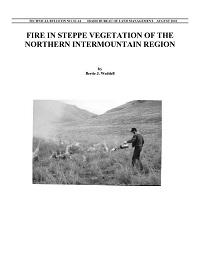Fire in Steppe Vegetation of the Northern Intermountain Region

Managers often want to restore historical disturbance regimes. In the northern intermountain region, there is considerable interest in using fire as a management tool to accomplish a variety of objectives in steppe vegetation. Little information is available on the fire regimes of northern intermountain steppe vegetation before the arrival of Euroamericans. Similarly, we know little about how often Native Americans set fire to intermountain grasslands. Dry coniferous forests experienced frequent low-intensity fires, many of which resulted from human activities. It is likely that some of these natural and anthropogenic fires also burned steppe vegetation; however, the frequency and timing of those fires are not known. Soon after Euroamericans arrived in the region, fires may have become more frequent, but eventually fire suppression in uplands and the cessation of burning by Native Americans probably reduced the frequency of fire at moderate elevations. It is unlikely that fire suppression was effective in steep canyons.
Native perennial bunchgrasses are susceptible to damage by fire because their meristematic tissues are located near ground level, they grow by means of tillers rather than rhizomes, and they reproduce by seeds. In addition, species that form very compact tufts and are phenologically advanced are especially susceptible. Idaho fescue has all of these characteristics. Native perennials are least vulnerable to fire when they are dormant, in summer. This is when most naturally started fires would have occurred in the past. Perennial forbs and shrubs that are able to regenerate from underground storage organs usually recover from burning.
There is evidence that seedling recruitment in the rare Spalding’s catchfly increases when communities dominated by rough fescue are burned. This is thought to be due to the removal of litter by fire; however, it is less likely that litter limits recruitment in intermountain steppes, where less litter is produced. Fire damages microbiotic crusts, and crust recovery after burning may take years or even centuries. Annuals increase after fires if enough seeds survive to repopulate a site or if they can colonize it. Before the arrival of Eurasian annuals with superior adaptations for colonizing disturbed sites, these post-fire changes in community composition were transient, but this is no longer the case.
The fire ecology of intermountain steppe is influenced by its distinctive physiognomy and phenology. Although dry forests were negatively impacted by fire suppression, the evidence for a similar situation in steppe communities, which have much lower fuel loads, is less compelling. Furthermore, burned stands of native steppe vegetation are vulnerable to invasion by cheatgrass and other annual exotics, an event which can irreversibly alter community composition.
